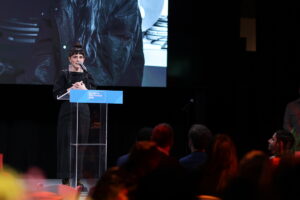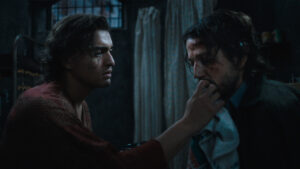Nick Fortugno speaking at the 2012 New Frontier Story Lab. Photo by Ryan Muirhead.
Royale Ziegler, Social Media Manager
Anyone who starts their presentation, full-suited, gingham shirt, and purple-checkered tie, by renaming it Aesthetics #FTW, has my full attention. A game designer, teacher, artist, and second-time New Frontier Story Lab Advisor, Nick Fortugno’s pretty much a perfect human. With a passion for creating emotion through experiences, his work designing video games for interactivity is perfectly suited for a #transmedia Lab such as this one.
So, what does it mean to design for interactivity and how does it connect to storytelling? As Fortugno puts it, interactivity itself is a medium that has aesthetics and can be narrativized. Essentially, “The Aesthetics of Interactivity” in game design comes down to a game’s mechanics, dynamics, and aesthetics. The mechanics being the parameters of interactivity at their most basic level; the dynamics, the rules that create the parameters by which you can engage with the system; and the aesthetics, the feelings created by the behaviors produced by the dynamics. To illustrate his point—thankfully for us non-gaming folk— Fortugno breaks the audience members into groups of five and asks us to play along.
And so we play: Twenty Questions, Variant 1. Each group is asked to nominate a “judge” who will then choose a noun, though not a proper noun. The rest of the group is tasked with guessing, in 20 questions, but an unlimited amount of time, that noun. Our team, the super-smart group that we are (shout out to The Goggles), correctly guesses the noun in six tries. Cat. Shockingly, this was not my noun choice. Ready for the second round, Fortugno lays out the rules for Twenty Questions, Variant 2. The rules are exactly the same. Except for one twist. We have an unlimited amount of guesses, but only 90 seconds to make them. Can you guess what happened next? Chaos.
By changing only one rule, he changed the whole emotion and feel of the game. And when the feeling changed, so did the actions. Crushed by the mounting pressure of the ticking clock, we made less thoughtful guesses, worked less cooperatively to make them and ultimately failed to guess the noun. Rules –> Behavior –> Emotion. Now we get it. Fortugno then goes on to ask the audience which variation of the game was more fun, which they would play again. Amazingly, the room is split. This is because the “fun” in games is entirely subjective. Bringing him to his next point, that when designing a game, one should not focus on creating “fun,” but instead create an experience reflective of the emotion it seeks to produce.
Shifting gears, Fortugno begins to discuss a range of games, asking pointedly, “May I have the PS3 please?” to demonstrate. One such game, Heavy Rain, is purposefully designed with difficult button combinations at more challenging stages of the game. Design choices are made to emulate the difficulty of the task, such as crawling through a room filled with electric wiring, as if one were to do it in real life. Another example of how design aesthetics create a narrative within a game is with Passage. This game, while relatively simplistic, communicates a powerful experience. Working as a team, a couple navigates through a virtual word, unable to unattach. As the game goes on, the visual queues such as tombstones, start to shape the narrative and we learn that the characters are aging. Perspective is used to further tell the story—at the beginning of the game, the “future” path is less focused, and as we near the end, the “past” becomes blurry. So is life.
The takeaway: As long as you have interactivity, unless it is completely transparent and uninspired (think “turning” the page on a Kindle), you are making an aesthetic statement. Therefore, any interactive experience a work contains must be thought of as the aesthetics of the piece. Make interactivity part of your story.







